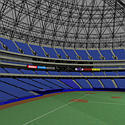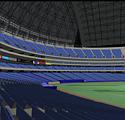|
One of the interesting problems facing global illumination researchers
is how to make their programs efficient for various types of models.
One extreme type of model is know as the "stadium scene."
Many small objects are placed around the perimeter of a large, open space.
Light from many sources has a clear path to many objects.
What better way to evaluate an algorithm's ability to handle this situation
than to build such a model?
Chris constructed a virtual version of the Skydome for this purpose.
 The stadium's 60,000 seats and thousands of light sources
present a very serious challenge to global illumination programs.
These images were created by a ray tracer using simulated lighting.
The model is still too much of a challenge for most other types of renders.
The stadium's 60,000 seats and thousands of light sources
present a very serious challenge to global illumination programs.
These images were created by a ray tracer using simulated lighting.
The model is still too much of a challenge for most other types of renders.
 Since many small objects are often located in the distance,
it would be advantageous to approximate groups of them with simpler data.
Automating this process can be difficult.
This view demonstrates that one scene could use four or more
versions of the same data set:
Since many small objects are often located in the distance,
it would be advantageous to approximate groups of them with simpler data.
Automating this process can be difficult.
This view demonstrates that one scene could use four or more
versions of the same data set:
- Complex seat model in near foreground
- Simple seat model in medium foreground
- "Row" version of seating when individual seats are indistinguishable.
- "Section" version of seating when individual rows are indistinguishable.
Simplified geometries and texture maps may be useful
for solving these problems.
| 
